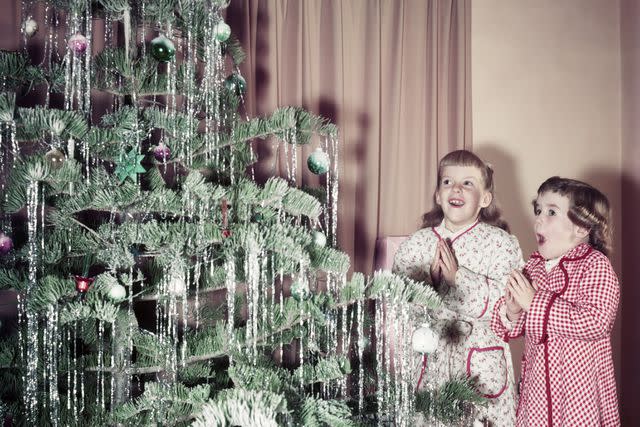Does Anyone Hang Tinsel On Their Christmas Trees Anymore?
The tinsel tradition is long-running, but the rules have changed a little surrounding our favorite tree trimming option.
It wasn’t Christmas at Grammy and Pop-Pops until a squat little tree was tucked snug in the corner and dressed in antique ornaments and tinsel. I never gave much thought to the tinsel, until I was grown and found myself always looking around hopeful for a little shimmer with every Christmas season that passed. The trends these days seem to be big bow toppers (of which I am a fan) and enough sparkle to give even Santa’s eyes a little extra twinkle—but tinsel seems to have ducked out of the scene.

H. Armstrong Roberts/ClassicStock/Getty
While tinsel isn’t always a good option for a busy family with tiny foot traffic (baby cousins, curious pets, etc.), I do look forward to the day when I can take up the tinsel tradition for my own children and grandchildren. For now, I’m brushing up on my tinsel trivia so I can regale everyone who listens. Even if there’s no tinsel bedecking the trees on our annual Christmas party circuit, this is one Christmas tradition that’s worth bringing back.
Why Do We Hang Tinsel On Christmas Trees?
Putting tinsel on trees is a tradition that has been around far longer than our grandparents’ generation, though it has evolved both in material and purpose. Many contend that it was first introduced in Germany in the early 1600s. At the time, tinsel was made of real strands of silver that had been hammered thin. They were used to reflect the candlelight on the tree—a tradition we’ve thankfully left in the past. If hammered tinsel sounds expensive now, it was then too. Different materials were used throughout the years before settling on the much more economical kind we use today.
What Is Tinsel Made Of?
While the original stuff was worth a hefty sum, you can pick up a bag of tinsel for $3 nowadays. That’s because the modern-day adaptation is no longer made of precious metals but, instead, PVC or polyvinyl chloride. It’s the same material used to make PVC pipe, but in flexible form. It’s inexpensive, which means this decorating technique is an easy way to fill out your tree if you’re short on ornaments. You can find it offered in just about any color under the sun, though silver is the best choice if you’re looking to mimic the appearance of icicles.
What Should You Do With Tinsel After Christmas?
Tinsel is, unfortunately, not recyclable. Recycling services like that in Austin, Texas, request homeowners remove it from their tree before setting it out for curbside collection. And don’t even think about tossing the tinsel in the trash! Collect it in neat strands and store it for use next year. Take a small piece of cardboard to hang the tinsel over, then secure with a loose ribbon or string so it doesn’t become dented. Place the strands in a zip-top bag and you’ll be all set for bringing back this tradition for many years to come.
What Is Our Modern Day Tinsel?
Despite the fact that tinsel cannot be recycled, and has to be fully removed from a tree prior to setting that item out for curbside recycling, tinsel is seeing somewhat of a comeback. That classic Christmas sparkle is still out there for grabs, and if you're a hardcore tinsel fan who cannot give up your favorite method of sparkling up that tree, take heart. It comes in so many different colors now, it's almost impossible to resist.
On the other hand, if you are ready to give up tinsel in favor of other, more eco-minded methods of trimming a tree, your best alternative might be ribbon. Bear in mind that some ribbon—similar to tinsel—cannot be recycled. But some can, and if you are flexible enough to hunt down just the right embellishment, you will still win Christmas.
For more Southern Living news, make sure to sign up for our newsletter!
Read the original article on Southern Living.

